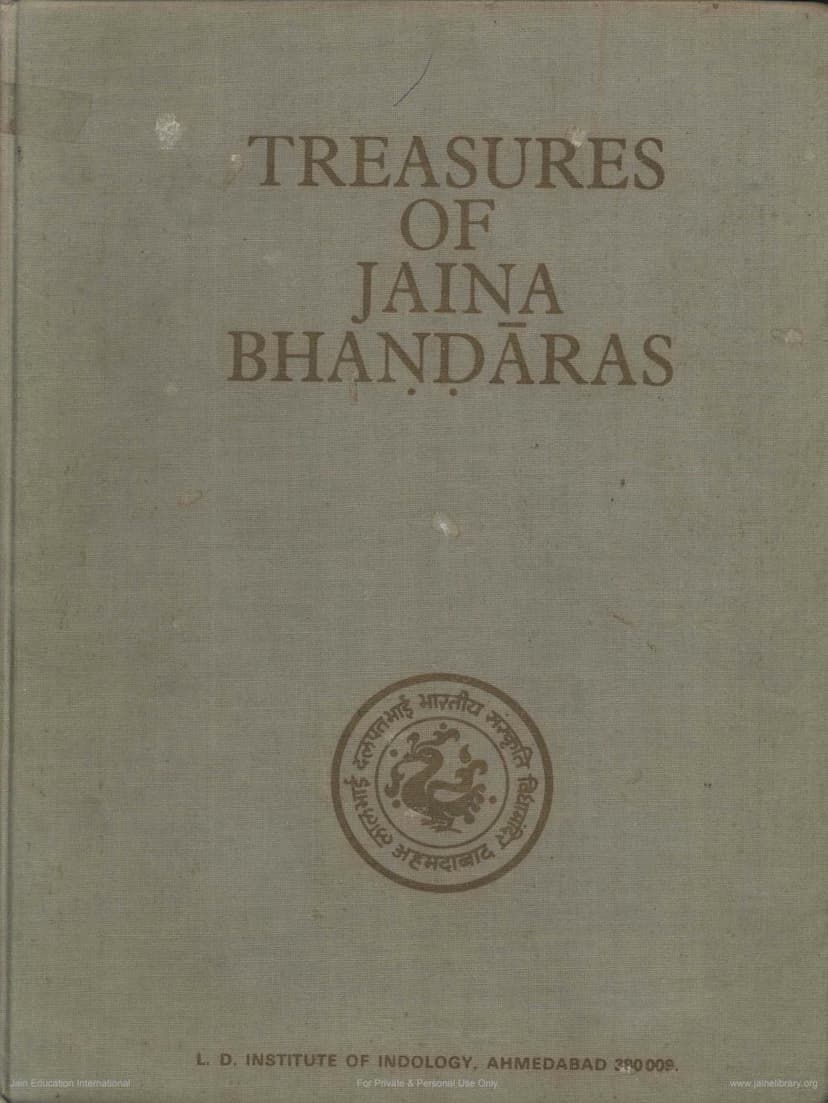Treasures Of Jaina Bhandaras
Added to library: September 2, 2025

Summary
This document is a catalog of an exhibition and subsequent publication titled "Treasures of Jaina Bhandaras" by Umakant P. Shah, Dalsukh Malvania, and Nagin J. Shah, published by the L. D. Institute of Indology, Ahmedabad, in 1978. The catalog serves as a comprehensive record of artifacts, manuscripts, and artworks from various Jaina Bhandāras (Jaina manuscript repositories) across Gujarat and Rajasthan.
The exhibition and publication were organized to coincide with the 2500th Nirvāṇa Celebrations of Lord Mahāvīra. The primary aim was to showcase the rich cultural and artistic heritage preserved within Jaina Bhandāras, which extend beyond religious and philosophical texts to include miniature paintings, illustrated manuscripts, artistic book covers, invitation scrolls (Vijñaptipatras), cloth paintings (paṭas), and other art objects.
Key aspects highlighted in the document include:
- Preservation of Heritage: Jaina Bhandāras are credited with preserving a vast collection of important Sanskrit, Prakrit, and Apabhramsa works on diverse subjects, both secular and religious.
- Artistic Treasures: Beyond manuscripts, these collections contain valuable art pieces such as miniature paintings, illuminated manuscripts, artistic book covers (pāṭhums), scrolls, and devotional paintings on cloth (paṭas).
- Exhibition and Cataloging: An exhibition of these antiquities was held at the L. D. Institute of Indology from November 16-30, 1975, as part of the Mahāvīra Nirvāṇa celebrations. This catalog was created to make the exhibited material accessible to scholars and the public.
- Art Historical Significance: The catalog emphasizes the importance of the unearthed paintings in shedding light on artistic activities in Gujarat during the medieval period, filling gaps, and connecting artistic traditions. Dr. Umakant P. Shah contributed "Notes on Art," detailing the evolution and characteristics of Jaina miniature paintings from the 11th to the 19th centuries, discussing various schools, styles, and influences (including Persian and Mughal).
- Scope of the Collection: The catalog meticulously lists and describes a wide array of items, including:
- Palm-leaf Manuscripts: Covering Agama and their commentaries, non-canonical Prakaraṇas, Jaina philosophy, biographies (Carita), narratives (Kathā), hymns (Stotras), and non-Jaina works.
- Paper Manuscripts: A vast collection including various Jaina philosophical and literary works, commentaries on non-Jaina works, secular texts, historical documents, and works in Gujarati and Vrajabhāṣā.
- Manuscripts with Citralipi: Manuscripts featuring decorative scripts.
- Book Covers: Wooden and paper-based book covers, some elaborately decorated.
- Illustrated Manuscripts: A significant section detailing illustrated manuscripts on both palm-leaf and paper, often highlighted for their use of golden or silver ink, and exploring their artistic styles, themes, and dating.
- Paintings on Cloth (Paṭas), Mantra, Yantra: Including devotional and cosmographical charts.
- Vijñaptipatras: Illustrated invitation letters for monks.
- Bronzes and Other Art Articles: Including Jaina images, shrines, and decorative items.
- Collaboration and Funding: The publication was made possible through the cooperation of numerous Jaina Bhandāras and received financial assistance from the Government of Gujarat. The L. D. Institute of Indology, particularly its Director, Dr. N. J. Shah, and editors Dalasukh Malavnia and Nagin J. Shah, played a crucial role.
- Methodology: The catalog provides detailed descriptions, including the manuscript's subject, author, place and date of copying, material (palm-leaf, paper, cloth), size, and any notable features like illustrations or inscriptions. The "Notes on Art" section offers critical art historical analysis of the material.
In essence, "Treasures of Jaina Bhandāras" is a significant scholarly catalog that serves as a vital resource for understanding the breadth and depth of Jaina material culture, particularly its artistic and manuscript traditions, with a strong focus on the art of painting in Western India.